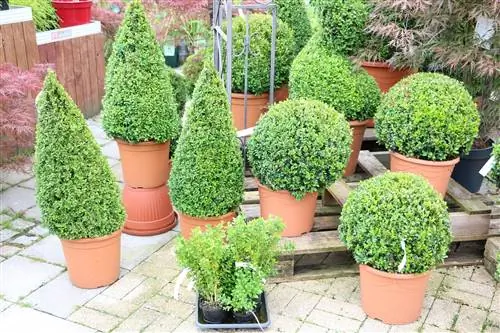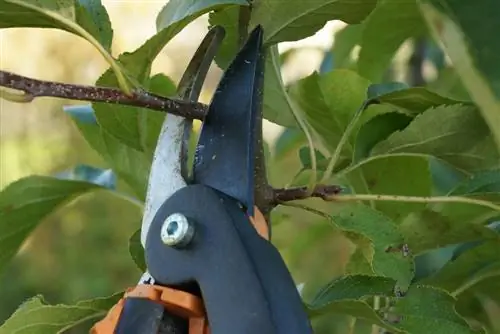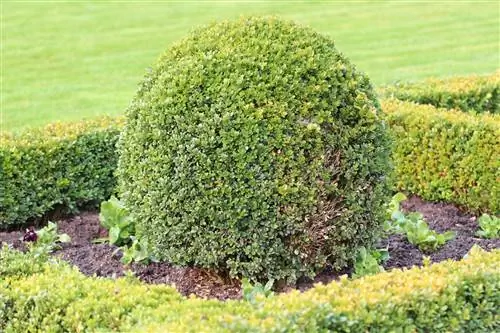- Author admin [email protected].
- Public 2023-12-17 03:39.
- Last modified 2025-01-24 12:45.
A beautifully trimmed hedge or bushes and shrubs, presented as a natural sculpture, have long been at home in front gardens as well as modern gardens. And in public areas such as in palace gardens or in front of museums, trees are often given topiary. People have been dealing with this topic since ancient times.
While some buy these little mini masterpieces already cut into shape from a hardware store or a tree nursery, others make the effort to shape their trees accordingly. And this requires not only a little imagination, but also manual skills, the right tools and sufficient knowledge about trees. Because ornamental trees cannot be trimmed at will.
Ornamental trees that cannot be cut to shape
Not all trees are also ornamental trees and are suitable for topiary. When purchasing or selecting the right trees, make sure that you choose the following trees:
- Yew
- Boxwood
- Pine
- Cypresses
- Hazelnut
- Robinias
- and some maple species
There are of course other trees that would be suitable. In principle, every shrub, bush or hedge can be trimmed individually. Some are just a little more “unruly” than other varieties. In the best case scenario, you should choose trees that do not lose their leaves even in winter. This means you always have beautiful ornamental trees in your garden to enjoy, even in the cold season. In addition, as a beginner you should always choose simple trees. These would be, for example, cypresses or boxwood. Both types are easy to cut and shape, even for beginners. And if you would rather add a topiary hedge, then this will also have a beautiful effect on your garden.
Possible topiaries
You are completely free to decide on the possible shapes that you can cut into your trees. The expert differentiates between basic shapes, mixed shapes, hedges and gates as well as tree walls. To get started, it's worth starting with simple shapes, like spheres or cylindrical shapes. After a little practice, the shapes can become more unusual. How about donuts, a chair, a hat or even a watering can and a bucket? As I said, the possibilities are so diverse that even fairy-tale characters or something similar are conceivable. In hedges, however, waves, edges or even corners can be cut. Just as you wish.
Tip:
When trimming hedges, make sure that a harmonious overall picture is created. Don't choose an overly "wild" shape, but limit yourself to a light shape that can ultimately be recognized by the viewer.
Correct cutting time
Now the scissors cannot be used on the tree all year round for a quick cut. Rather, you should choose late February or early March or June and July. Be careful not to have a too hot day. Always cut only in the area where the wood is green. Otherwise you will end up with bald spots that don't look very attractive.
Tip:
Start cutting slowly and always focus on the result from time to time.
If this gradually matches the shape you are aiming for, then everything is fine. Otherwise, correct the cut and adjust accordingly.
How to cut correctly
Trees usually grow upwards in the first step. You can further promote this by only shortening the top shoot tips when making a cut. But since you want to make a topiary cut, you need abundance and a tree that also grows sideways. You can always achieve this if you remove the central shoot and thus encourage the side buds to sprout. If you then remove these side shoots, you will get the bushy shape you need for a topiary.
In the first step, a design cut must be made. This first cut determines the rough shape of the tree. The next cuts are then called maintenance cuts. They ensure that the wood becomes increasingly bushy and dense, so that in the end a clearly visible shape without bare spots can emerge. Finally comes the topiary, which determines the final shape and is usually carried out in June.
Tools and supplies required
Here you have to decide between manual and electric tools. Please decide for yourself which tools you really need. It is always very nice to have a hedge trimmer that can be operated electrically for the first trimming. The finishing touches at the end can also be done with manual scissors. With this you can cut more precisely. This is particularly important if a very unusual and complex shape is to be created. You will also need secateurs, lawn edgers, a guide line, a measuring stick and a plumb bob. If the wood is so large that you cannot see it, a ladder is essential. If the height is very high, even a working platform.
If you are unsure about creating the shape, then work with stencils. This is particularly recommended if you want to create a sphere.
Tip:
Since you only need the special tool every now and then, it is not absolutely necessary that you buy everything.
You can also borrow this from many hardware stores and garden centers. However, make a reservation in good time, as the time window for cutting is quite small and other gardening enthusiasts might also come up with the idea of renting.
Frequently asked questions
Which woods are suitable for a topiary?
It's always good if you choose hardy trees that don't lose their leaves. Yew, cypress, boxwood, hornbeam and azaleas are therefore well suited. Of course you can also use other trees.
When can you cut?
The best time for cutting is at the end of February and March. You can also prune in June and July. You should choose June for the final topiary.
What shapes are possible?
Everything is possible. The question is whether you can cut everything yourself. For this reason, it is always better to start with simple shapes and then slowly work your way up to more difficult shapes.
What you should know about topiary trimming of ornamental trees in brief
- First of all, you should know that some trees require regular pruning, such as roses that bloom more often or ornamental shrubs that bloom in late summer.
- Very valuable trees such as witch hazel, magnolias or laburnum should not be cut at all.
- Pruning increases the abundance of flowers and fruit or a specific plant shape is achieved.
- When pruning, all shoots that have been damaged by disease, injury or frost are first cut off.
- Rotten, mostly brownish shoots are also cut back to he althy wood.
- Furthermore, all thin and weak shoots are cut down to the base.
- With a thinning cut, however, all shoots that are older than three to four years are cut off directly above the ground.
- Once this work has been done, you can start cutting the shape. Make sure there are no holes here!
- As a rule, a pruning or thinning cut is already done and the ornamental shrub has been put “in its place”.
- When cutting, it is crucial that you use the right tool.
Conclusion: When should you cut ornamental trees?
In autumn you should only cut enough to prevent damage from wind breakage or snow load. Pruning only takes place in winter, but only when the weather is frost-free. This is usually the case in February. Woody plants that bloom in summer, such as buddleia and espalier bushes, should be radically cut back to around 20 cm from February to March. However, trees that bloom in spring are only cut back after flowering.






